SUMMARY
This is AI generated summarization, which may have errors. For context, always refer to the full article.

SAN JOSE, Antique – The waters were quite calm from the mainland up to Batbatan in the town of Culasi, Antique but after passing the island, it became a rough ride. An hour from Culasi and 3 hours away from our destination, the waves were already as high as a 5-foot grown man, and were so angry that it swept the boat from side to side.
We were dripping wet.
Several of the boat’s crew would stand near the fore and every time the waves would toss the boat from left to right, they would also skip from side to side in order to balance the boat and ensure that we don’t sink.
This was in December 8, 2013, exactly a month after super typhoon Yolanda (Haiyan) devastated Samar, Leyte, Northern Iloilo, and coastal towns of Antique. I was invited by a close family friend, Marilou Llavan, to join and document a relief mission in the island barangay of Maniguin since she knew I was an active citizen journalist for Typhoon Yolanda Story Hub Visayas that covered stories in Panay Island.
The idyllic island
Culasi has 3 island barangays; Malalison, Batbatan, and Maniguin. Malalison is about 30 minutes away from the mainland, Batbatan is about an hour away, and Maniguin is about 4 hours away.
The motorized boats used for traversing the island of Guimaras have comfortable seats, life jackets, and are protected by tarpaulins. However, the boats used to travel to the islands of Culasi are fishing boats which are very uncomfortable. They have no protection against the searing heat of the sun nor the waves, and there are no life jackets on board.
We reached the white sand island of Maniguin or what the natives call Maningning past noon. Geographically, Maniguin has a land area of around 35 hectares, but what makes this island majestic are the 50 hectares of floating seaweed farms surrounding the island.
Since the island is completely surrounded by the seaweed farms, it is impossible for the big motorized boats to enter and dock directly on the island. Therefore, small motorized bancas have to transport the people and cargo from the middle of the sea to the island itself.
Relief mission like no other

After a few minutes in this condition, the team began to worry.
I began praying the Holy Rosary which I finished in a record time of 5 minutes. While I was praying, I heard someone making strange sounds beside me. Upon looking to my left, I saw Llavan singing religious songs to lessen her tension and nervousness.
Among our cargo were 200 containers of purified water. In her panic, Llavan told the boat’s crew to throw several of the containers overboard to lessen the weight of the boat. The crew was laughing when they assured us that we are safe and this is just normal. They even recommended that we come back and experience the really dangerous waters.
Upon arrival, we only have to wait for a few minutes before several small fishing boats and motorized bancas arrived to transport us to the island.

After lunch, we distributed the relief goods per family in the barangay. Each family was given an equal share of relief goods and 20 liters of purified water. We also distributed medicines for the children and elderly.
At around 3:30 p.m., we decided to go home and we are actually looking forward in reaching the mainland due to the 4-hour trip on disturbed and violent waters.
Two small motorized bancas transported us to the big boat. Several villagers also travelling to the mainland were transported in the first banca while eight of us occupied the second banca.
The first banca reached the boat first and they were assisted by the crew. When our banca reached the boat, one of our excited companions immediately climbed over. The rest of us also stood up and prepared to board the boat.
Maybe because of excitement or just being plain tired, we neglect to notice that while 6 of us occupy the left side of the banca, only two others are in the right side. Upon standing, this caused the banca to go out of balance on the left side.
Apparently when this happens, your first instinct should be to jump away from the banca to avoid being hit or pulled down. Unluckily for me, I was standing in the middle part of the boat which is enclosed by the katig or the wood that balances the boat on both sides. Not to mention that there are usually a lot of ropes and nylon here supporting the boat.
In my panic when the banca overturned, I held on tight on the pole in the middle of the boat instead of jumping away. I was pulled down with the boat. Since I don’t know how to swim and I don’t know what to do, I was already panicking.
According to the fishermen, that part of the sea is about 10 to 12 feet deep. The boat began pulling me down and I was already underwater for about 20 seconds. My oxygen supply in my lungs was already depleted and I was taking in water. I even felt as if my throat was on fire with all the salt.
It seems that the fishermen did not expect me in this situation and they thought I can swim so they prioritized saving Llavan and the others first. Then they realized I was nowhere to be found. One of the fishermen dived in and saw me being pulled down.
He swam to me and tried pulling me up. At first, he experienced difficulty which he thought was due to my weight. What he didn’t know that when I was pulled down, a piece of rope was holding me tightly under my left knee which made it difficult for me to swim away.
After several pulls later, I was able to break away from the rope only to be trapped by a nylon cord on my left ankle. It took several pulls before I was able to swim away with the fisherman’s help.
Exhausted and traumatized, I spent the journey back to the mainland lying down and trying to sleep. By this time, the waves are already very violent and high. It rocked the boat from side to side and we were drenching wet. Llavan keeps massaging my hands to lessen my nervousness. We reached the mainland around 7:30 in the evening.
Before we were deployed to gather news and feature stories, Professor Hazel Villa stressed that “no story is worth your life.”
These were the very same words that entered my mind as I was being pulled down by the banca.
But then, as journalists, occupational hazards are already common. Sometimes, in our goal of delivering the news, we tend to forget our own safety. After all, being a journalist means going out of your comfort zone in the pursuit of news. – Rappler.com
Anthony Mondragon is a volunteer for the Typhoon Yolanda Story Hub Visayas, a citizen journalism portal created in November 2013 by veteran journalists, student writers, mobile journalists, and photographers based in Iloilo City. The Hub delivers reports from across Panay Island, especially the severely damaged and minimally covered northern Iloilo area and the provinces of Antique, Capiz, and Aklan.
Add a comment
How does this make you feel?
There are no comments yet. Add your comment to start the conversation.